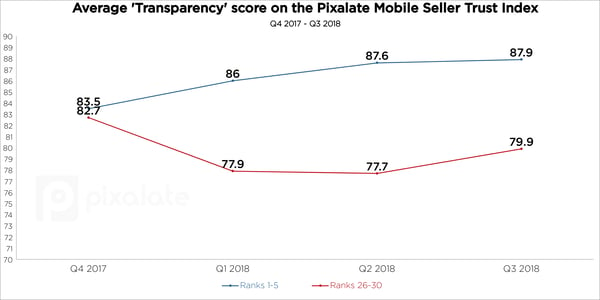Pixalate recently released the Q3 2018 Seller Trust Indexes, which rank the overall quality of programmatic sellers across desktop and mobile web (GSTI), mobile in-app (MSTI), and cross-device video (VSTI).
The index rankings and scores are a compilation of key variables, including invalid traffic for both GIVT and SIVT, reach, transparency, and more. Pixalate has been publishing the indexes for several years now, so we decided to take a look back at some historical data to identify some industry-wide trends.
Top mobile in-app sellers have become increasingly transparent
Potential response to calls for more transparency within mobile
‘Transparency’ score among top MSTI companies has increased every quarter for the past year
Widening gap between the top-ranking companies and lower-ranking companies
Some companies are meeting the call for more transparency, but not all
Mobile in-app transparency has become a priority for top sellers
We aggregated the top MSTI performances (those that have an overall ranking of 1-5) against those that ranked further down the list (ranked 26-30) to see how they fared in the ‘Transparency’ department over the last 12 months:

This chart shows that in Q4 2017, the companies that ranked 1-5 had only slightly better ‘Transparency’ scores than those that ranked 26-30 (the difference was just 0.8).
However, at the start of 2018, companies that had high overall rankings on the MSTI had significantly better scores in the ‘Transparency’ category as well (86 vs. 77.9, for a difference of 8.1). In Q2 2018, the gap widened yet again (87.6 vs. 77.7, difference of 9.9).
In our most recent indexes, Q3 2018, those that ranked 1-5 on the MSTI slightly improved their average transparency scores (up to 87.9), while those that ranked 26-30 also saw a slight uptick, up to 79.9 — but the gap remains significantly larger than it was a year ago.
Here’s how we define ‘transparency’ for our index: “Availability of device and user information. For example, a seller with a high device identification percentage will score high on this scale.”
In a recent report highlighting the top challenges advertising face in mobile marketing and targeting, eMarketer noted that a “lack of transparency of publisher data is a huge issue for mobile marketers, and it contributes to ad fraud and poor targeting.”
That report came out in early 2018. Have the top in-app sellers since heeded the call?
A year ago, companies that ranked at the top of the mobile in-app seller quality rankings were not noticeably more transparent than those ranked closer to the bottom. But according to our data, that has started to change.
So how transparent are your mobile in-app sellers? Find out by downloading the latest Mobile Seller Trust Index.
*By entering your email address and clicking Subscribe, you are agreeing to our Terms of Use and Privacy Policy.
These Stories on Mobile
*By entering your email address and clicking Subscribe, you are agreeing to our Terms of Use and Privacy Policy.

Disclaimer: The content of this page reflects Pixalate’s opinions with respect to the factors that Pixalate believes can be useful to the digital media industry. Any proprietary data shared is grounded in Pixalate’s proprietary technology and analytics, which Pixalate is continuously evaluating and updating. Any references to outside sources should not be construed as endorsements. Pixalate’s opinions are just that - opinion, not facts or guarantees.
Per the MRC, “'Fraud' is not intended to represent fraud as defined in various laws, statutes and ordinances or as conventionally used in U.S. Court or other legal proceedings, but rather a custom definition strictly for advertising measurement purposes. Also per the MRC, “‘Invalid Traffic’ is defined generally as traffic that does not meet certain ad serving quality or completeness criteria, or otherwise does not represent legitimate ad traffic that should be included in measurement counts. Among the reasons why ad traffic may be deemed invalid is it is a result of non-human traffic (spiders, bots, etc.), or activity designed to produce fraudulent traffic.”

